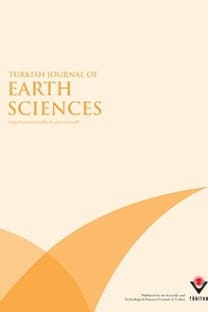A model for estimating parameters of rotational landslide using a first-order differential equation
A model for estimating parameters of rotational landslide using a first-order differential equation
___
- Burns WJ, Jeffrey AC, Kaya E, Lina MA (2010). Analysis of elevation changes detected from multi-temporal LiDAR surveys in forested landslide terrain in western Oregon. Environ Eng Geosci 16: 315-341.
- Celik CT (2016). A robust approach for determining rotational landslide area from two epochs of LiDAR data. 16th SGEM GeoConference on Informatics, Geodesy and Mine Surveying, Geoinformatics and Remote Sensing, Bulgaria, June, Book 2, Vol. 2. pp. 33-38.
- Chen W, Li X, Wang Y, Chen G, Liu S (2014). Forested landslide detection using LiDAR data and the random forest algorithm: a case study of the Three Gorges, China. Remote Sens Environ 152: 291-301.
- Eker R, Aydın A (2014). Assessment of forest road conditions in terms of landslide susceptibility: a case study in Yığılca Forest Directorate (Turkey). Turk J Agric For 38: 281-290.
- Fernández T, Jiménez J, Fernández P, El Hamdouni R, Cardenal FJ, Delgado J, Irigaray C, Chacón J (2008). Automatic detection of landslide features with remote sensing techniques in the Betic Cordilleras (Granada, Southern Spain). Int Soc Photogramme 37, Part B8, 351-356.
- Glenn NF, Streutker DR, Chadwick DJ, Thackray GD, Dorsch SJ (2006). Analysis of LiDAR-derived topographic information for characterizing and differentiating landslide morphology and activity. Geomorphology 73: 131-148.
- Hastaoğlu KÖ (2013). Investigation of the groundwater effect on slow-motion landslides by using dynamic Kalman filtering method with GPS: Koyulhisar town center. Turkish J Earth Sci 22: 1033-1046.
- Hussin HY, Zumpano V, Reichenbach P, Sterlacchini S, Micu M, Westen CV, Bălteanu D (2016). Different landslide sampling strategies in a grid-based bi-variate statistical susceptibility model. Geomorphology 253: 508-523.
- Jaboyedoff M, Oppikofer T, Abellan A, Derron MH, Loye A, Metzger R, Pedrazzini A (2012). Use of LIDAR in landslide investigations: a review. Nat Hazards 61: 5-28.
- McKean J, Roering J (2004). Objective landslide detection and surface morphology mapping using high-resolution airborne laser altimetry. Geomorphology 57: 331-351.
- Otsu N (1979). A threshold selection method from gray-level histograms. IEEE T Syst Man Cybern Syst 9: 62-66.
- Shahabi H, Hashim M (2015). Landslide susceptibility mapping using GIS-based statistical models and remote sensing data in tropical environment. Sci Rep 5: 9899.
- Shan J, Toth CK (2009). Topographic Laser Ranging and Scanning Principles and Processing. Boca Raton, FL, USA: CRC Press.
- Van Westen C, Castellonos E, Kuriakose SL (2008). Spatial data for landslide susceptibility, hazard, and vulnerability assessment: an overview. Eng Geol 102: 112-131.
- Varnes DJ (1978). Slope Movement Types and Processes. In: Schuster RL, Krizek RJ, editors. Landslides: Analysis and Control. Transportation and Road Research Board, National Academy of Science, Special Report 176, Washington D. C., pp. 11-33.
- ISSN: 1300-0985
- Yayın Aralığı: 6
- Yayıncı: TÜBİTAK
Muhammed Zeynel ÖZTÜRK, Mehmet Furkan ŞENER, Mesut ŞİMŞEK, Mustafa UTLU
MUHAMMED ZEYNEL ÖZTÜRK, MESUT ŞİMŞEK, MUSTAFA UTLU, MEHMET FURKAN ŞENER
Seyed Javad YOUSEF, Abbas MORADIAN, Hamid AHMADIPOUR
SEYED JAVAD YOUSEFI, ABBAS MORADIAN, HAMID AHMADIPOUR
Estimation of the crustal structure in Central Anatolia (Turkey) using receiver functions
A model for estimating parameters of rotational landslide using a first-order differential equation
